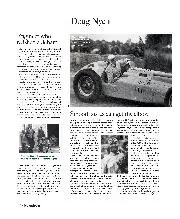
Smooth styles can get the elbow
New World Champion Jenson Button has always been praised for being a notably smooth driver, not only when he was bog-slow – as the average extremely smooth driver often is…

From the 25th anniversary of the revival of A. Lange and Söhne to the half-century of the famous Rolex ‘cyclops’ date window, 2019 has been a year of horological birthdays – with one of the more notable being a diving watch that’s become a cult collector’s piece.
The model in question is the Doxa Sub 200 T.Graph that became the production version of the SUB concept shown at the 1967 Baselworld watch fair. As well as being water resistant to 300 metres (100 metres more than the Rolex Submariner), the SUB concept also featured a patented rotating bezel incorporating the U.S. Navy’s ‘no decompression’ limits, a ratchet bracelet clasp and a screaming orange dial.
The first watch to use the colour, the Sub Concept was not designed merely to look the part, but as a functional instrument that was obtainable only from dive shops.
Doxa’s product boss, Urs Eschle, was inspired to make such a serious underwater tool by the burgeoning number of magazine articles, documentaries and TV shows that came about following the perfection of SCUBA during the 1950s. Diving watches, such as the aforementioned Submariner and Blancpain’s 50 Fathoms, had been available for more than a decade, but they were mostly worn by military and professional divers and were expensive.

Eschle saw a market for a more affordable watch made for the growing army of amateur divers. In 1962 he developed the original Doxa Sub with the help of Claude Wesly, a member of aqualung co-inventor Jacques Cousteau’s underwater exploration team.
Eschle refined the range, releasing both the Sub 200 T. Graph and the Sub 300T Conquistador in 1969, the latter being the first to feature a helium release valve in order to prevent a build-up of tiny molecules of the gas from blowing the crystal off during a diver’s ascent to the surface.
The SUB 300T and its derivatives became the default equipment of many professional and amateur divers, even finding fame in film on the wrists of Robert Redford in 1975’s Three Days of the Condor and Matthew McConaughey in 2005’s Sahara.
To mark both the 130th anniversary of the Doxa dial name and the 50th anniversary of the Sub 200, the firm is introducing two special models – an 18 carat gold Sub 200 T. Graph powered by an original Valjoux 7734 movement and available in just 13 examples, and a steel re-issue of the standard Sub 200 that will be released in an edition of 130.
Doxa SUB 200T Graph in gold. £37,000 on rubber strap, £59,000 on special request gold bracelet; SUB 200 130th anniversary, stainless steel (pictured), £1000, doxawatches.com

First designed for drivers, but made considerably more famous by becoming the first watch to be worn on the moon during the Apollo XI expedition of 1969, the Omega Speedmaster has been re-commissioned in this platinum-cased special edition. Fitted with a ‘reborn’ version of the Calibre 321 hand-wound movement used in the original 1957 model, it gets an onyx dial, while the three subdials are made from meteorite.
Omega Speedmaster Moonwatch 321. £45,000, omega-watches.com

Bamford Watch Department started out as a maverick maker of bespoke Rolex models. Now it is the official customiser of TAG Heuer and Zenith – and has partnered with jeweller/artist Black Badger (AKA James Thompson) to create 10 Carrera models with dials made from ‘Fordite’ – the name for the accumulation of overspray in automotive paint booths. The dials are made by slicing the surplus paint into discs, revealing the unique swirl of colours within.
BWD X Black Badger Fordite TAG Heuer Carrera £5500, bamfordwatchdepartment.com
Motor Sport’s monthly watch review Precision is written by renowned luxury goods specialist Simon de Burton